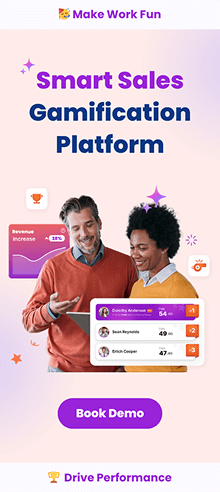Have you ever sat through a webinar that was… boring? Does your sales team lack the motivation to go above and beyond with their sales goals? Maybe, you want to ensure your new hires have a seamless onboarding experience so you can improve retention rates and retain top talent.
The truth is: You can’t just flip through a PowerPoint slide or give your team a sales quota for each month and hope for the best. You need to keep their goals top of mind and guide them towards the desired learning outcomes.
When brainstorming new ideas to build an engaging workplace, you’ve likely run into a relatively new buzzword, Gamification.
Gamification is the best way to ensure people are engaged and motivated in and outside the workplace. Adding gamification elements to the work environment, virtual event, or classroom allows you to create a thriving atmosphere built on collaboration, user engagement, and some friendly competition.
However, you may be wondering: What exactly is Gamification? Since the term is so versatile, it can be hard to pinpoint what it means and how to use it to your advantage correctly.
Don’t worry. We’re here to help.
Here’s everything you need to know about gamification meaning.
What is Gamification?

Gamification is adding game elements to everyday tasks, activities, and events.
To put it in even simpler terms, it’s like turning mundane tasks into a video game! With the right game elements and mechanics, you can keep individuals engaged during a webinar, encourage team members to go above and beyond or help students retain more information during lessons.
Leaders, managers, and educators can apply these game design elements to almost any situation. Whether you’re updating a weekly scoreboard in the office, giving out points to overachievers, or rewarding top talent with badges in nongame contexts: There is always a way to gamify the world around you. Once you turn everyday activities into engaging experiences, you can feel confident that your team will deliver big results and see smiles all ’round!
The Origin of Gamification
Gamification has been around for quite some time. In fact, you’ve likely participated in a few activities that utilize gamification solutions… You just might not realize it. According to NPR, Gamification is based on trends in technology and society that have continuously shaped the world around us for the last 25 to 30 years.
For example, think about the show The Biggest Loser. This reality TV show put people in a somewhat embarrassing limelight. But together, these game show participants take on a weight loss journey on national television. Throughout the show, the hosts use many game elements to motivate people to lose weight, including rewards and leaderboards. With the help of Gamification, participants on the show were able to lose up to 100 pounds in a short time frame. Every week during the weigh-in, they were hit with a dose of serotonin if they met their goals.
This is just one example of Gamification. Gamification examples are everywhere, whether you’re embedding the game elements in the customer experience, your sales strategy, or a free webinar.
However, Gamification meaning in business has taken on a new look and feel that is much different than game shows. Now, professionals can take advantage of the same benefits of The Biggest Loser and add these game design elements to their work week. Once implemented, you can track your employee’s success and continue to reward customers and employees, the same way The Biggest Loser did on national television.
What does gamify mean?
To gamify something is to add Gamification to a task or activity. For example, let’s say you add a progress bar that shows how many calls each sales rep makes in a given week. This progress bar or leaderboard will break down your team’s progress for the month and allow them to visualize their success. Adding a progress bar to the process would be to “gamify” the experience for your sales team. A business leader would incorporate a game design element (progress bar) into an everyday activity(sales calls).
What are game mechanics?
The game mechanics are the rules and actions your team needs to take during the experience. It’s the driving force of the gamified experience and provides the roadmap your team needs to take to earn a reward.
What are game elements?
Game elements are the gamified tools you choose to use. This can include leaderboards, badges, levels, a tiered prize system, or a progress point. These elements are the tools that keep participation high, and individuals engaged.
How to create a gamification strategy
Think of your strategy as your game plan. This road map shows managers, team leaders, teachers, or speakers how they need to adjust their approach using Gamification. When building a strategy, there are a few questions you’ll want to ask yourself before you get started.
These include:
- What are your performance goals?
- What’s your purpose?
- Who will be participating?
- What is the timeline?
- What are the rules?
- What do individuals need to do to win the award?
- What is the reward?
Once you understand the why you can better understand which game elements are more suitable for the experience. For example, let’s say you want your team to exceed their revenue goals for Q1. Whoever meets all their revenue goals will get an extra bonus on their paycheck. You can use this as your goal to choose how the game elements and mechanics will work together.
Gamification best practices
Once you understand the meaning of Gamification, you’ll find that these tools can be used everywhere around you.
However, before you start gamifying every experience, there are a few best practices you’ll need to keep in mind.
Celebrate everyone that’s participating, not just the winner
If the attention is always on the individual at the top of the sales leaderboard, the rest of the team will feel unmotivated to continue. Don’t forget to celebrate the individuals that brought in the most points that month, week, or day. Send a shoutout to the sales rep that brought in the big deal that week or someone who brought in new business. Every big and small accomplishment deserves to be celebrated!
Make sure your gamification initiatives are measurable
You want to be able to measure the success of your gamification techniques. This will help you understand the value of the game elements and decide to continue using these examples of Gamification or if you need to restructure the experience.
Focus on the experience, not the rewards
If the experience is only about rewards or winning something big, individuals will forget to pay attention to what really matters. While you want to come to the table with fun, creative prizes for everyone, you don’t want to make them the main focal point.
Instead, focus on how everyone can benefit personally and professionally. How will gamifying the experience help them in their professional development? How will it help them grow as a working professional?
The benefits of adding game elements
Increase participation
One of the best benefits of using game mechanics is to increase participation and to help individuals focus on important information. Individuals will be more likely to pay attention to discussions and solve problems when rewards are on the line.
Improve organization productivity
Is your team feeling burnt out with the workweek chaos? Are they finding it hard to stay focused between 9-5? One survey suggests that 90% of employees feel more productive at work with Gamification. This means with the right gamification platform; you can help your team stay productive.
Keep remote and hybrid teams engaged
In today’s digital age, teams have never been so connected and disconnected simultaneously. In fact, some individuals never get to meet their coworkers face-to-face while working with a company. With enterprise gamification, you can inspire your team to connect, communicate, and collaborate with the people they spent 9-5 with. This will help them build stronger relationships with their remote coworkers and help you create your company culture.
Enhance brand loyalty
A returning customer is more valuable than a one-time purchaser. With customer loyalty programs or game mechanics, you can inspire your customers to refer their friends or provide discounts for future purchases.
How can businesses benefit from Gamification?
The beauty of Gamification is its versatility. There is no right or wrong way to use these game elements in the workplace.
Here are seven ways you can use Gamification for your company’s benefit:
Sales Teams
Gamification inspires friendly competition. This is a great way to encourage your sales team to go above and beyond their goals. With the help of sales gamification software, you can also boost sales and help your team reach their sales goals.
Education
Gamifying the classroom is a fun way to help students engage with lessons and retain more information. When gamification elements are added to the lessons, students are more likely to pay attention during classroom discussions and participate.
With game elements, you can also recognize students for their achievements with badges and leaderboards. This helps them visualize their success and can motivate people to further their education and come up on top.
Event Planners
Have a virtual event coming up? Consider brainstorming ways to use gamification strategies to amplify the experience for attendees. Whether it’s a quick session of trivia, a scavenger hunt, or an interactive Q&A session with a prize at the end – these small game mechanics can leave a favorable impact on every participant.
Customer Loyalty Programs
Gamification is also an invaluable tool that can help you create a loyal customer base. With the help of Gamification, you can build a loyalty program that rewards loyalty and gives customers a reason to continue shopping with your company.
Onboarding New Hires
Let’s face it – being a new employee at a new job can be stressful. Between the paperwork and meeting new coworkers, you can’t expect your new employees to remember everything they’re told during the first few weeks.
With Gamification, you can ensure your new employees retain the information. You can use icebreakers to help them remember names, pop quizzes about company culture, and provide meaningful workshops using game principles.
Training Programs
Research suggests that 83% of employees feel more motivated when training is gamified. Depending on the industry you’re working in, employee training can contain tons of technical, must-know information.
As an employer, you want to ensure these pieces of training are worthwhile and that your team leaves with the information they need to transition into a different role.
Coaching
Coaching is an integral part of a thriving workplace experience. One-on-one coaching sessions inspire employees to take the initiative, set goals, and always motivate them to be the best version of themselves.
Businesses can use Gamification to help keep employees engaged during these coaching sessions. It helps drive positive change and set tasks. Managers can use game elements to help individuals visualize their progress and reward initiatives.
Experience gamification with Spinify
Gamification can be a meaningful tool businesses can use for corporate training, employee engagement, and learning environments. When implemented correctly, you can create an interactive workplace and thriving workplace. However, building out the game mechanics and elements on your own can be a daunting task. Don’t worry; we’re here to help.
At Spinify, we have sales performance management software designed to help your team visualize their success and gamify their targets. Our platform helps you create a thriving, gamified workplace from which you and your employees can benefit.
Book a demo today if you’re ready to build a gamified workplace and learn the true Gamification meaning.



